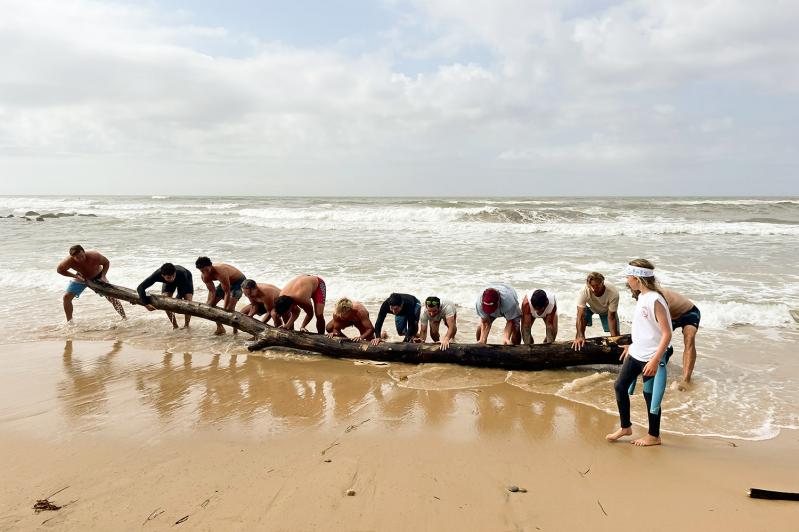It’s not sharks, Portuguese man-o-wars, dogs, plovers, or summer people cluttering the beach these past few weeks, but trees that have floated down the Connecticut River, some all the way from Vermont, and eventually out to the Atlantic.
“There’s maybe been some hurricanes where we’ve had similar debris, but I would say this is right up there with the best of them,” said Tim Treadwell, senior harbormaster for East Hampton Town Marine Patrol. “It’s kind of interesting how much stuff came from New England and how it found its way here.”
Since mid-July, the National Weather Service has issued warnings to mariners in Long Island Sound about the “Long Island Sound debris field” caused by recent flooding across New England.
“This will create some hazards for boaters, swimmers, and watercraft in the affected area. At this time reports of the debris consist mainly of logs, which have been washing ashore,” read the Aug. 1 marine weather statement issued by the National Weather Service.
Mr. Treadwell said it is particularly an issue for boaters at night, “regardless of how good your electronics are.”
“There were tremendous rains three weeks ago, with small towns underwater,” said John Olsen, an operations controller with the Coast Guard. “All that water eventually makes its way into the Connecticut River. The river left its banks and cleared them of all the driftwood, debris, even some docks and boats. It ends up in the Long Island Sound. Once there, it’ll either head east or west with the rotary current.”
Mr. Olsen said if the debris makes it to the Race, between Fishers and Plum Islands, it shoots out of the sound, drifts into Gardiner’s Bay, and makes its way around Montauk Point. “Along-shore currents then drag it down the beaches. It’s all going to end up on a shore,” he said.
Or perhaps just bobbing around offshore, alarming beachgoers. Last week, someone phoned East Hampton Town Police when they thought they spotted two distressed swimmers a mile offshore. Three minutes after the call came in, the town had a Jet Ski on the scene. What the caller thought were swimmers was nothing more than a 14-foot log.
“It’s kind of unusual that we have this much,” said John Ryan Jr., the head lifeguard for East Hampton Town. “These things can be thousands of pounds. You get steamrolled by something like that, it’s going to leave a mark. We’re constantly taking people out of the water if these large logs end up in the breaks.”
What do you do with a thousand-pound log getting slammed by waves? “It’s a timing game. You wrap it with a tow rope so you can steer well clear of it in the surf, and you wait for it to wash up, instead of trying to roll them up. You don’t want to be on the wrong side of them. It’s just another reason people should be swimming in lifeguard protected areas,” he said.
“Some have been full trees,” said Drew Smith, the head lifeguard for East Hampton Village. As big as they are, he said they’re easier to spot from the lifeguard stand than they are from water level. “If they’re a size we can remove, we tend to pile them up through the day and remove them from the beach later. If they’re too big, we try to winch them out of the water, but sometimes all we can do is monitor them and keep people away.” He said some have been as large as telephone poles.
Mr. Smith said there have also been larger than usual amounts of seaweed on the ocean beaches. “Our concern there is people play with it and sometimes fishing lures are hidden. When we were getting all the Portuguese man-o-wars they were also often tangled in the seaweed too.”
Renee Chaifetz, who lives along the Napeague stretch south of Montauk Highway, said that she and her neighbors have collected over 100 bags of seaweed from the beach. “It smells. There can be dead fish. But I’ve been coming out here since the ‘70s and I’ve never seen the logs.” She has been disappointed with the town’s response to clearing the logs on unprotected beaches. “It’s dangerous. Huge logs are floating. There are swimmers out there that can get hurt.”
Mr. Treadwell said the town prioritizes cleaning the guarded beaches. “Town Parks has removed many truckloads of debris from the beaches since this began. They’ve been doing that in their regular beach cleanups. They’ve had to put extra personnel out there to remove a lot of the debris so the beach rake can get through it. When they have time, they will rake outside the lifeguarded areas.”
Sometimes it’s just hard to keep up with Mother Nature.
Mr. Olsen at the Coast Guard said driftwood has long collected on shorelines, but at some much more than others. “The Washington and Oregon coastlines are covered in driftwood, so much that they encourage people to have bonfires.”




